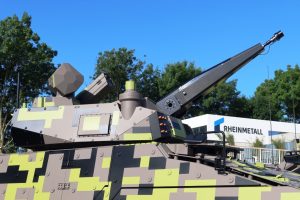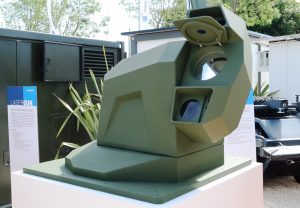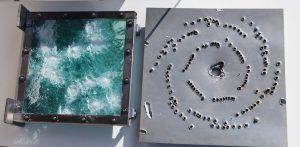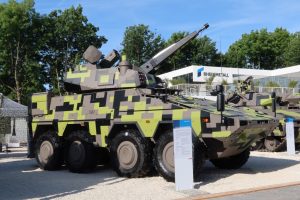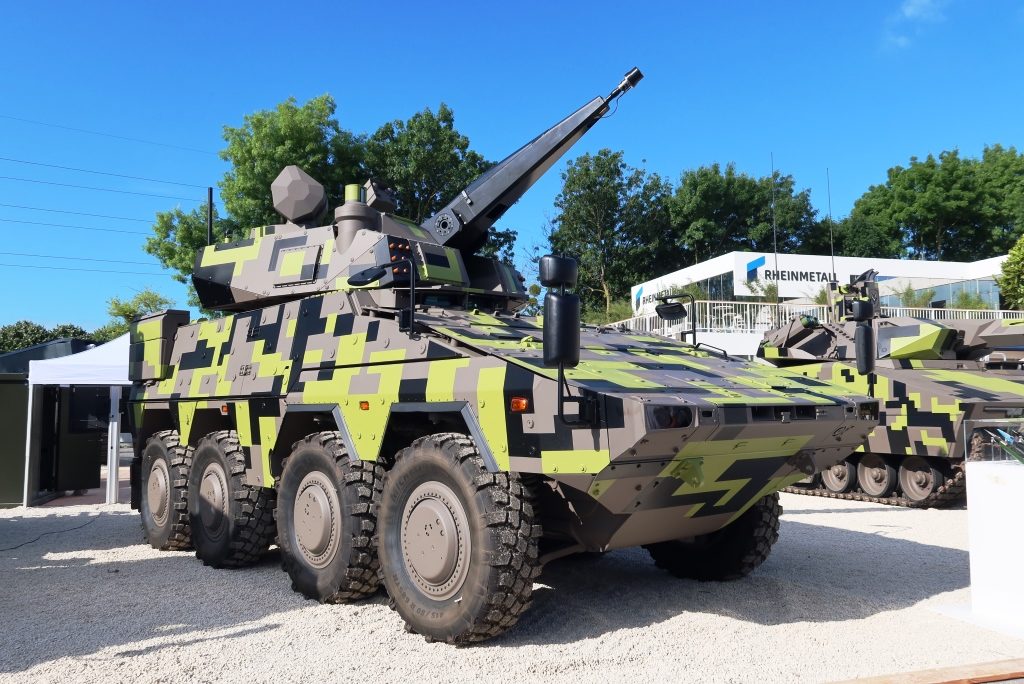
Countering RAM, drones and other flying objects with highly mobile assets, Rheinmetall’s solutions
At Eurosatory 2022 the Skyranger 30 turret installed onto a Boxer 8×8 armoured vehicle was the main mobile air defence item exhibited at the Rheinmetall stand. Compared to the Skyranger 35 the much lighter mass, 2.4 tonnes versus 4.6 tonnes, makes it a more flexible system in terms of platform integration. Its killing power is well sufficient to deal with one of the key problems of today air threat on the battlefield, drones and loitering munitions, while it also provides a good efficiency against the RAM (Rocket Artillery Mortar) threat. According to Oerlikon officials the C-RAM issue is back on the agenda of different armies, among them the British and Hungarian ones, the latter having a requirement of such a turret integrated onto a Lynx 41 chassis, already adopted by that army in the infantry fighting vehicle configuration. The Hungarian requirement calls for the integration of two Mistral 3 missiles, by MBDA, in the turret, something that should be easily done as those missiles are of the fire-and-forget type.
Rheinmetall is working on new drone threats, size, reduced radar cross section and extensive use of plastics being some of the issues, the main one remaining however that of swarms. Live firings are being conducted to adjust algorithms leading to optimise the use of AHEAD rounds against swarms of drones. Tests were carried out against an eight-drone swarm. The mission was carried out tracking all drones at the same time, shooting against the swarm centre of gravity, an 18-round burst allowing to neutralise the whole swarm, although most of the drones were destroyed with the first 6 rounds.
Rheinmetall would like to extend its solution to non-military operations. To allow operations in civilian areas EW solutions such as emission locators and jammers are being considered, as well as laser solutions, the mock-up of the company laser gun being exhibited, destined to be a key C-UAS effector on the so-called the Skyranger 30 HEL (High Energy Laser) variant. This is based on a beam-forming unit of new design. This doesn’t mean that Rheinmetall is not working anymore to further improve conventional ammunition performances; studies are ongoing but company officials told EDR On-Line that it is too early to release any data. Especially in the 30 mm calibre something is moving, the Skyranger 30 using the KCA 30×173 mm originally developed as an aircraft gun, it was installed on Saab’s Viggen, capable of 1,200 rounds per minute.
Rheinmetall modernised it with the insertion of new technologies, made it compatible with the use of AHEAD rounds, and in its new form the gun is close to qualification. The AMMR radar, the FIRST infrared scanner as well as an optronic sensor ensure target acquisition and tracking. As said Hungary might become the launch customer, “After February 24th we had numerous requests for information and quotation from different countries, mainly European, as the Skyranger solution, either in 35 or 30 mm, fills a gap in the mobile air defence field, aimed at protecting armoured formations from new threats, and the reshuffling of some old Gepard with its twin 35 mm cannons shows it,” company sources said.
Germany NNbS (Nah- und Nächstbereichsschutz, close range protection)requirement aimed initially at a 12.7 mm machine gun and missiles solution, however this seems to have evolved towards a longer range effector, in the form of a Skyranger 30 integrated with Stinger missiles, that should be installed on a Puma or Boxer chassis. EDR On-Line understood that the British initial interest was for the Skyranger 30, to be installed probably on the Boxer, the 8×8 being acquired in quantities by the British Army; however the UK MoD has now apparently veered towards the larger calibre, and is considering now the Skyranger 35.
During the swarm experiment the Skyranger 30 was installed over an RMMV HX2 6×6 truck fitted with specially developed stabilisers. According to Rheinmetall 24 months would be needed to reach full product status, however the aim is to reduce this time to half.
Back to the Hungarian potential solution, according to company experts integrating the turret into the Lynx KF41 should present less challenges than fitting it onto an 8×8 wheeled vehicle, although the Boxer also has a modular design. Beside the reduced logistic and training footprint due to full commonality with IFVs and other variants that will soon enter service with the Hungarian Army, the large protected volume allows certain flexibility. Beside the vehicle driver, the Lynx configuration would have two operators console in the rear module, for commander and gunner. To ensure 24/7 availability additional personnel can be hosted in the extra space. Another choice might be carrying extra ammunition, although a resupply vehicle solution is also being considered. According to information the integration of the Mistral 3 is not part of the development. MBDA France will provide interface documents allowing Rheinmetall to provide the system fitted for those missiles but not with. Should a contract be signed before the end of summer 2022, Rheinmetall states that a demonstrator will be delivered in 2-years time, an initial operational capability being planned for late 2025-early 2026, although what exactly IOC means for Hungary remains classified.
Photos by P. Valpolini

